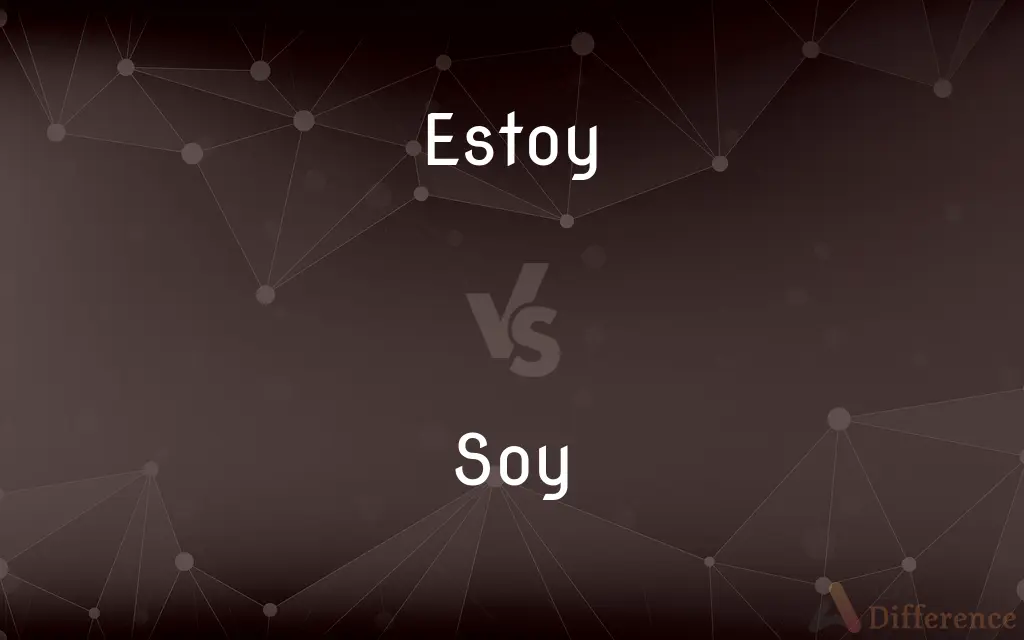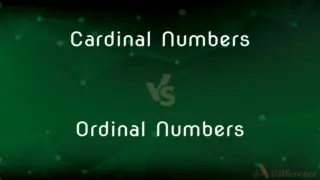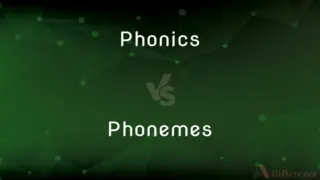Estoy vs. Soy — What's the Difference?
By Tayyaba Rehman & Fiza Rafique — Published on February 1, 2024
"Estoy" is used for temporary states or locations ("I am"), while "Soy" is used for permanent characteristics, identities, or professions ("I am").

Difference Between Estoy and Soy
Table of Contents
ADVERTISEMENT
Key Differences
"Estoy" is a form of the Spanish verb "estar," which denotes temporary conditions or locations. For example, "Estoy cansado" means "I am tired," implying a temporary state. "Soy" comes from the verb "ser" and is used for permanent traits, identities, or professions, such as in "Soy médico," meaning "I am a doctor." This distinction emphasizes the nature of the condition being described, whether it is expected to change or remain constant.
When using "Estoy," one refers to conditions that can vary over time, such as feelings, physical states, or locations. For instance, "Estoy en casa" means "I am at home," highlighting a current, changeable location. On the other hand, "Soy" is reserved for aspects of identity, origin, or characteristics that define a person or object more fundamentally and permanently, like "Soy de España," which means "I am from Spain."
The choice between "Estoy" and "Soy" can alter the meaning of a sentence significantly. Saying "Estoy aburrido" means "I am bored" (a temporary state), whereas "Soy aburrido" could be interpreted as "I am boring," suggesting a more permanent characteristic. This highlights the importance of context and the inherent nature of the attribute being described.
In teaching Spanish, it's crucial to emphasize the "Estoy" versus "Soy" distinction to avoid confusion and ensure clear communication. Understanding when to use each verb allows learners to more accurately express feelings, locations, identities, and more, adhering to the nuanced rules of Spanish grammar.
While "Estoy" caters to the fluid aspects of life and experiences, "Soy" anchors in the enduring qualities that compose our identities and roles. This fundamental difference is a key aspect of Spanish and is pivotal in mastering the language, as it reflects the speaker's perception and intended meaning behind each statement.
ADVERTISEMENT
Comparison Chart
Verb
Form of "estar"
Form of "ser"
Usage
Temporary states, conditions, locations
Permanent characteristics, identity, professions
Example Context
Feelings, weather, location
Nationality, profession, essential qualities
Changeability
Yes, often subject to change
No, generally consistent over time
Implication in a Sentence
Current, possibly fleeting situation
Inherent, defining trait or fact
Compare with Definitions
Estoy
Indicates current physical or emotional state.
Estoy cansado después del largo viaje.
Soy
Expresses identity or inherent characteristics.
Soy profesor de matemáticas.
Estoy
Used to express one's location at the moment.
Estoy en la biblioteca estudiando.
Soy
States nationality or place of origin.
Soy canadiense de nacimiento.
Estoy
Conveys a current state of being or action.
Estoy aprendiendo español rápidamente.
Soy
Indicates membership or affiliation.
Soy miembro de un club de lectura.
Estoy
Describes temporary conditions or feelings.
Estoy feliz por las buenas noticias.
Soy
Used for permanent traits or qualities.
Soy una persona muy paciente.
Estoy
Reflects an immediate situation or action.
Estoy comiendo en mi restaurante favorito.
Soy
The soybean.
Soy
Soy sauce.
Soy
A common East Asian liquid sauce, made by subjecting boiled beans to long fermentation and then long digestion in salt and water.
I like a little soy with my rice.
Soy
Soybeans, or the protein derived from them.
These candles are made from soy.
The soy crop is looking good this year.
This diet doesn't let me eat soy.
Soy
A Chinese and Japanese liquid sauce for fish, etc., made by subjecting boiled beans (esp. soybeans), or beans and meal, to long fermentation and then long digestion in salt and water.
Soy
The soybean.
Soy
A source of oil; used for forage and soil improvement and as food
Soy
Erect bushy hairy annual herb having trifoliate leaves and purple to pink flowers; extensively cultivated for food and forage and soil improvement but especially for its nutritious oil-rich seeds; native to Asia
Soy
Thin sauce made of fermented soy beans
Soy
Most highly proteinaceous vegetable crop known
Soy
Describes one's profession or occupation.
Soy escritor y trabajo desde casa.
Common Curiosities
What does "Soy" mean?
"Soy" also means "I am," but it's used for permanent characteristics or identities.
When is "Soy" appropriate to use?
"Soy" is suitable for unchanging aspects, such as your nationality, profession, or inherent traits.
What does "Estoy" mean?
"Estoy" means "I am" in the context of temporary states or locations.
How does "Estoy" relate to "estar"?
"Estoy" is the first-person singular present indicative form of "estar."
Can "Soy" describe a temporary job?
Even if the job is temporary, "Soy" is used because professions are considered part of one's identity.
Is "Soy" ever used for temporary situations?
No, "Soy" is reserved for aspects that define identity or inherent qualities.
When should I use "Estoy"?
Use "Estoy" for conditions that can change, like feelings, states, or your location.
Can "Estoy" and "Soy" be used interchangeably?
No, they cannot due to their distinct implications regarding permanence and temporariness.
Is "Estoy" only for physical locations?
No, "Estoy" can also describe temporary emotional states or conditions.
Can "Estoy" ever imply permanence?
No, "Estoy" inherently suggests a temporary or current state.
How is "Soy" connected to "ser"?
"Soy" is the first-person singular present indicative form of "ser."
Does "Estoy" have a future or past tense?
Yes, "estar" has all tenses, but "Estoy" is specifically present tense.
What if I misuse "Estoy" and "Soy"?
Misusing them can lead to confusion or incorrect implications about permanence or identity.
What is a common mistake learners make with "Estoy" and "Soy"?
A common mistake is using "Soy" for temporary states or "Estoy" for permanent traits, confusing the nature of the condition being described.
Can "Soy" indicate a future profession?
"Soy" can be used for future professions if they are seen as part of one's inevitable identity.
Share Your Discovery

Previous Comparison
Cardinal Numbers vs. Ordinal Numbers
Next Comparison
Phonics vs. PhonemesAuthor Spotlight
Written by
Tayyaba RehmanTayyaba Rehman is a distinguished writer, currently serving as a primary contributor to askdifference.com. As a researcher in semantics and etymology, Tayyaba's passion for the complexity of languages and their distinctions has found a perfect home on the platform. Tayyaba delves into the intricacies of language, distinguishing between commonly confused words and phrases, thereby providing clarity for readers worldwide.
Co-written by
Fiza RafiqueFiza Rafique is a skilled content writer at AskDifference.com, where she meticulously refines and enhances written pieces. Drawing from her vast editorial expertise, Fiza ensures clarity, accuracy, and precision in every article. Passionate about language, she continually seeks to elevate the quality of content for readers worldwide.














































